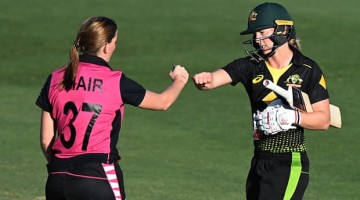
Sri Lanka v Australia: Glenn Maxwell’s record-breaking series
The rapid reaction: Well, that was just a bizarre. A run chase that was shaping up to be a complete domination from a rampaging Australian top-order, somehow became a tense four-wicket victory to finish a challenging tour on a winning note. Adam Zampa and James Faulkner set up the victory with the ball, while Glenn Maxwell added to his growing highlights reel with a record-equalling batting blitz.
The score: Sri Lanka 9-128 off 20 overs (De Silva 62, Zampa 3-16) defeated by Australia 6-130 off 17.5 overs (Maxwell 66) by four wickets with 13 balls to spare in the second T20 at R. Premadasa Stadium, Colombo
The hero: If he hadn’t done so already, young leg-spinner Zampa has all but cemented his role as Australia’s go-to spinner in the limited-overs team. The Melbourne Stars leggie again delivered through the middle stages of the Sri Lankan innings, following a bright start from the home side’s top-order. Finishing with a new career-best in T20 internationals of 3-16 from his allotted four overs and leaking just the single boundary, Zampa applied the brakes as the hosts could only manage 4-31 from the moment he entered the attack for the seventh over through to the end of his spell seven overs later.
The record: Maxwell was at it again at the top of the order as he plundered the hapless Sri Lankan attack to once again silence the vocal home crowd packed in for the final match of the tour. When he sent another delivery sailing to the mid-off boundary, Maxwell brought up the equal-fastest T20 international half-century by an Australian from 18 balls. Maxwell reached the milestone in the same number of deliveries against Pakistan in the 2014 edition of the World T20, while opening partner David Warner also claims joint-ownership of the record with his effort against the West Indies back in 2010. While blistering by most standards, the duo still trails the overall record of Yuvraj Singh by a whopping six deliveries following his 12-ball blitz against England nine years ago.
The shot: Maxwell simply continued his exploits from the destruction in Kandy on Tuesday night, treating the attack with complete disdain as he toyed with the field through his audacious strokeplay and unwillingness to adhere to any existing cricket textbook. His reverse-sweeping was so good that it now barely elicits the same sense of wonder it once did, it’s now just firmly entrenched in the repertoire. Maxwell’s power-hitting still manages to amaze, however, as shown by the cleanest of hits in the fifth over of the chase. Having ditched the helmet, Maxwell resumed his one-way battle with Sachithra Senanayake. A gentle loft down the ground for four to begin the over was simply a taste of what was to come. The Sri Lankan opted for a friendly seam-up delivery that swung without venom outside off and Maxwell casually flayed it up and over the long-on boundary to offer some catching practice to the exuberant fans.
Play
The surprise: When the curtain was drawn on Maxwell’s show, most would have expected Khawaja or Head to stroll to the crease to continue the damage following their efforts in Tuesday’s world record total. The Australians surprised everyone when allrounder Moises Henriques emerged from the dugout, seemingly in an attempt to maintain a right-hand left-hand combination in the batting order. Henriques was soon on his way back to the pavilion, stumped off Sachith Pathirana for 1 to bring his tour tally to 19 runs from five innings at an average of 3.80, having danced down the wicket only to york himself. It didn’t deter the visitors from again opting to deploy another right-hander to join Warner, as Faulkner walked to the crease to steady the ship, only for things to become even more unstable.
The collapse: When Maxwell edged a Seekkuge Prasanna delivery on to his stumps for 66 off just 29 balls – earning himself a cheeky send-off from the leggie – it sparked a stunning collapse by the tourists with the loss of 4-6 in little more than two overs. But things could have been much worse following the run out of Faulkner to leave Australia at 4-99 in the 11th over. Khawaja walked to the crease and offered a return chance to Prasanna from his first delivery on a surface becoming increasingly tricky to overcome. The left-hander couldn’t make the most of his second chance with a 15-ball stay producing only six runs, while Matthew Wade fell a short time later for 14 via a miscued reverse sweep. Young gun Head ultimately sealed the deal with a heave over mid-wicket, helped over the line by Senanayake in the deep – Australia’s first boundary in more than 11 overs – and Warner’s men were able to breathe a sigh of relief.
The ball: It didn’t secure him a wicket, but Zampa’s delivery prior to the dismissal of Chamara Kapugedera was just about leg-spin perfection. Slight drift into the pads of the batsman to lure him ever so slightly out of his crease was followed by sharp turn past the outside edge and into the awaiting gloves of Peter Nevill. The gloveman’s effort to whip off the bails was only just beaten by the extension of Kapugedera’s back foot as he was deemed not out by the third umpire.
The catch: Zampa got his man with his next – far less threatening – delivery when captain Warner took a superb diving catch at mid-wicket. But it wasn’t even the skipper’s best catch of the night following his earlier effort to send Kusal Perera on his way for 22. Faulkner extracted the leading edge from the left-hander and Warner immediately began sprinting from his post at mid-on to reel in the skied ball. Matthew Wade, sans gloves, heard the call from his skipper to avoid a nasty collision and take a front-row seat to the full-length dive from one of the two Australians to feature in each of the 10 international matches on this tour.
The observation: Australia’s impressive performances with the white Kookaburra at the back-end of a long tour were highlighted by a Finch blitz, George Bailey’s consistency, some Maxwell magic and Starc doing Starc things. However, it was arguably the return to form from allrounder Faulkner that would have most pleased the Australian brains trust. The Player of the Final in last year’s World Cup triumph entered the series under pressure to recapture the form that had made him one of the most valuable players in limited-overs cricket. With Mitch Marsh rested from the shorter formats and Maxwell omitted from the ODI squad, Faulkner embraced the responsibility of being the side’s No.1 allrounder as he collected 14 wickets in his seven appearances on tour, while conceding a miserly 4.74 runs an over. On the slow surfaces found at each of the venues, Faulkner’s variations – he considers himself a pace-bowling spinner in these conditions – came to the fore as he got back to his deceptive best with a vast array of cutters and deliveries out the back of the hand. A fit and firing Faulkner not only adds another weapon to an already powerful bowling line-up, but also gives the National Selection Panel yet another headache ahead of ODI series against South Africa, New Zealand (home and away), and Pakistan in the next five months.
The farewell: After 87 Tests, 330 ODIs, 80 T20Is and 17,671 international runs across all formats, Dilshan was unable to produce one last knock to remember when he edged Hastings to Warner in just the second over of the match to depart with a solitary run to his name from three balls faced. A pair of wickets late in the piece gave the hosts a glimmer of hope in pulling off the unlikeliest of victories, but it wasn’t to be. It was by no means a fairytale finish, but so few are when the player has such an illustrious record behind them. Dilshan’s retirement leaves a significant hole at the top of the order in Sri Lanka’s limited-overs side, but the timing of the 39-year-old’s decision allows the team to find and develop a long-term replacement ahead of the 2019 World Cup and the World T20 hosted by Australia the following year.
The wash-up: Australia now head home where they will reflect on a tour that offered plenty of optimism when it began, but ultimately failed to deliver the success they so desperately sought in this part of the world. Dominance in the shorter formats won’t distract the powers that be from the efforts in the Test arena, as they now search for answers ahead of the much-anticipated tour of India in February and March of next year. For now, the team’s immediate focus turns to the ODI tour of South Africa that will serve as a competitive tune-up ahead of the home Test series against the Proteas in November, more than it will a chance to extend their stranglehold on the No.1 ODI ranking.
Categories: Cricket



